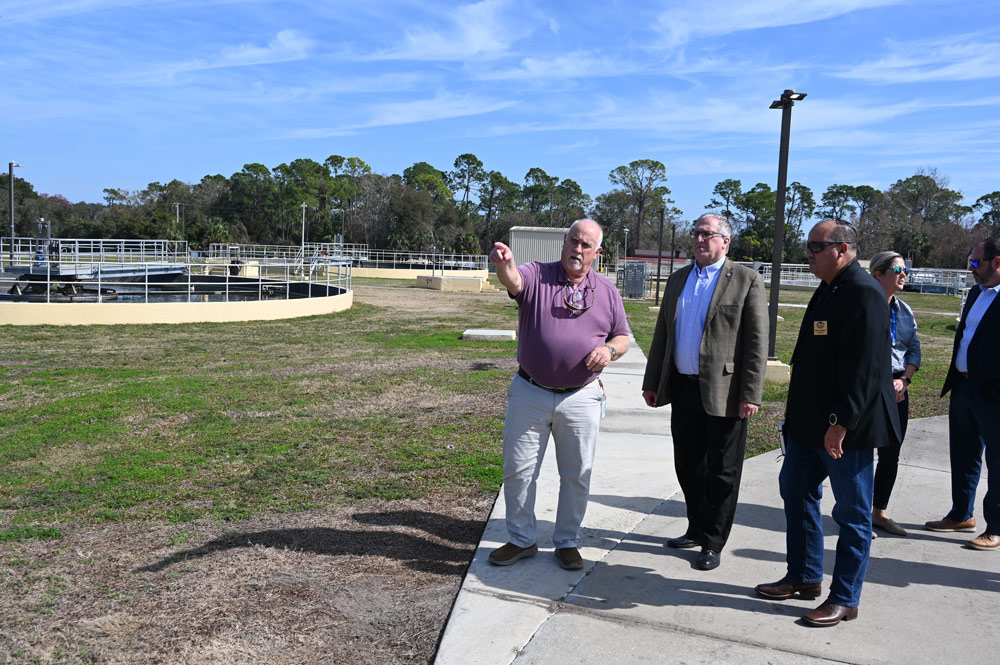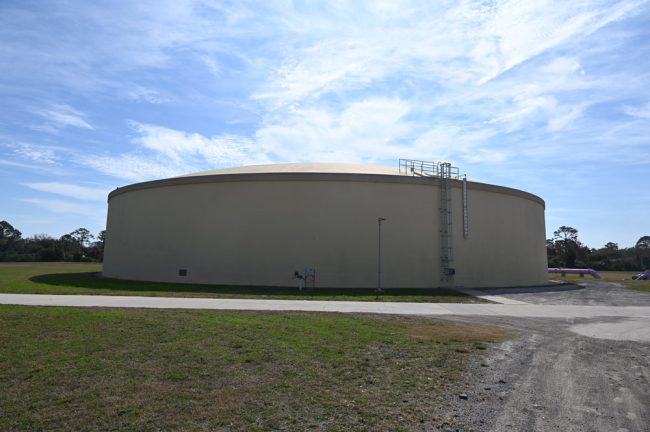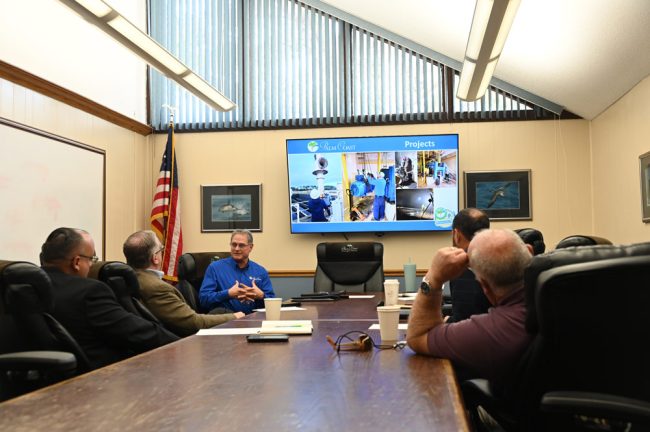
The first-ever visit by an aide to Sen. Rick Scott–or by any senator or his aides–to Palm Coast’s troubled Waste Water Treatment Plant #1 today left City Council member Charles Gambaro, who arranged the visit, thinking “it’s a 50-50 chance” that the city may get financial help to lessen a projected $240 million bill to upgrade and expand the sewer plant.
The more federal and state grants the city can secure, the less residents will have to pay in higher water and sewer rates. Gov. Ron DeSantis vetoed what would have been a $35 million appropriation for the sewer plant.
“Through the congressional process, there are no guarantees, but they’re willing to try,” Gambaro said moments after Barry Cotton, Scott’s Central Florida District Director, left the grounds of the sewer plant after a 90-minute visit. “They’re willing to provide letters of support for any grant, federal grant applications, or even appropriations projects.”
City staffers briefed Cotton on the plant’s history and challenges before he toured the 30-acre facility in the heart of the Woodlands. Cotton, who’d never been to Palm Coast before, took copious notes and asked numerous, technical questions–it was not a PR visit by any means–but made no promises.
“This is a critical need for our community, and we have to take action by asking for help or look at how we can generate that revenue locally, and it’s not a fun discussion,,” Gambaro told Cotton at the beginning of the briefing. “This is a critical need for our community, and I think we have to have an honest discussion about it.”
Palm Coast has two sewer plants. ITT, which built the original part of Palm Coast, built the older sewer plant in 1971 with a capacity of 300,000-gallon-per-day. The plant expanded over the years, adding capacity and changing hands, until the city bought it for $83 million in 2003. It now has a capacity of 6.83 million gallons per day.
But it’s officially at 99 percent capacity, with just 313,000 gallons per day of capacity left, and 70 to 75 percent of new utility customers’ waste streaming into the plant, Chief of Staff Jason DeLorenzo told Cotton. The rest flows to the city’s second sewer plant, which is being expanded from 2 to 4 million gallons per day.

When rain events drench the city, the plant goes over capacity, sometimes by millions of gallons: during Hurricane Milton last October, 18 million gallons per day were flowing through the plant for several days. Less than two weeks ago, a 1.5-inch rain storm caused capacity to be overrun by 1.5 million gallons the first day and 1.3 million gallons the second day, Interim City Manager Lauren Johnston said.
The state Division of Environmental Protection calculates capacity based on averages, and makes no distinction between house waste and stormwater, even though the two are significantly different. Because of rain events, those averages have exceeded the plant’s capacity for several months in 2024. And because of that, the plant is under a consent order by DEP to upgrade the plant. Hence the $240 million bill ahead. (That sum will rise over time because of inflation and rising costs.)
Cotton’s briefing was conducted by Peter Roussell, the city utility’s deputy director, Danny Ashburn, the utility manager of the wastewater division (he’s been with the utility since 1981, when it was still an ITT operation), Johnston and DeLorenzo.
“Everything we’re talking about today is capacity-driven’ Ashburn told Cotton. He outlined the priorities for the plant’s expansion, starting with a needed, 6 million-gallon “equalization tank” that could accumulate excess stormwater during heavy rain events so as not to overburden the plant.
The plant itself is facing a $90 million modernization, to be in line with state environmental regulations. The city is also hoping to build an additional 9 million-gallon equalization plant off site to store recycled water until it can be distributed. The equalization tanks can be built faster–in about a year–than the broader modernization of the plant, and provide immediate relief.
For residents and businesses, higher rates are on the way regardless, but that’s been the case every year since 2011. What’s still uncertain is by how much the rates will increase once the City Council approves the next schedule. The council hears a key presentation along those lines next week.
Ultimately, Gambaro said today, development impact fees–the one-time charge builders and developers pay every time they build a house, an apartment building or a business–will account for 60 percent of the needed capital costs, while rates will account for 40 percent. The council raised impact fees last year, but resisted raising rates just yet, as a previous schedule of rate hikes had still not rolled out completely (2024 was the last year of that cycle of rate increases).
The governor vetoed all water appropriations last year because those requests were shifted to the relatively new, $400 million fund generated by the Seminole Tribe gambling compact. “To this point we haven;t been able to unlock those dollars,” DeLorenzo said. “We submitted for this project, but it didn’t really meet the criteria,” Those criteria must be expanded if the city is to have a chance at some dollars from that pot, he said.
“We understand that we have to have some skin in the game for this part of the funding. We’re just asking for help now,” Gambaro told Scott’s senate aide, underscoring the fact that city residents and business will be doing their share.
Hurricane Milton was barely done dumping flood-level rains on Palm Coast when Gambaro, appointed to the City Council just days earlier, donned boots and fatigues and toured the city to take the measure of the storm’s impact. The city made it through almost unscathed, but at a cost, especially to its utility system. He contacted Scott’s office to understand the process for requesting federal infrastructure funds, then met with Scott’s policy team in D.C., setting up Cotton’s subsequent visit.
Gambaro said he is replicating the same efforts in Tallahassee. “What’s nice about being born and raised here in Florida is that a lot of my college classmates are the number two guy in the State Senate, and other representatives from around the state,” he said. “I’m doing everything I can to leverage my personal network and professional network to fight for the citizens of Palm Coast.”
![]()





























Mel says
“Troubled Wastewater Plant?” It’s only troubled because of Palm Coast’s spending priorities. The mismanagement in that cesspool should be investigated, or just level the entire city and start over with competent leadership. Palm Coast = State Embarrassment.
Doug says
The question I have is if our wastewater treatment situation is so dire why is the council approving every new development that comes in front of it? All the infrastructure in this town is falling behind, gridlock on the main thoroughfares and crumbling roads in the neighborhoods. It’s time to put a moratorium on any new developments until some of these situations are handled. A lesson could be learned from South Florida where areas were allowed to be built out and then they tried to figure out what to do to catch up. I lived thru that growing up and I see the same thing happening here decades later. Maybe it’s time to find somewhere new.
Deborah Coffey says
Good…with hopes that our water bill will go back to $150 instead of $300.
Photo Caption Guy says
Here’s what’s being said in the photo at the top of the story: “See Barry, over there the City built 356,009 single family houses with no wastewater facility. This one was built in 1989 and is barely hanging on – We are already charging residents and arm and a leg for what water we can provide.”
Joanne C says
Kudos to Mr. Gambero for making this happen! Nice to know that our new City Council member was a great pick.
Endless dark money says
The r cons all voted unanimously against all infrastructure funding, then tried to take credit for it locally when the democrats barely passed it on party lines. Republicans wanted citizens united, republicans stole the Supreme Court, republicans rolled back regulations like child labor environmental regs, labor agencies like the eeoc ,legal protections, theyd watch people starve for a nickel (usaid). They claim diversity is crashing airplanes while they allow unelected people to access all your information and money with no oversight! Remember when they complained about an email server lol! I guess people are nihilistic and wanted it. Enjoy the fascism! Maybe they will live stream the concentration camps to keep the masses in line or will they hide it like the fuhrer. Know who else removed birthright citizenship, staged a coup and only got a slap on the wrist, hated minorities and installed corporate oligarchs over government. If you said hitler you are correct! Make Germany great again was the campaign slogan. We know what the new murican salute is Elon did it behind the presidential seal. Teach your kids so they blend in!
FlaPharmTech says
Wondering how many PC residents are aware the severity the issues with our wastewater system are? This is a huge, stinky problem. Let’s HOPE we get the money. I heard, unverified, that each PC residence would have to pay $400 a month to pay for the EPA mandated fix. Gotta love PC government.
JimboXYZ says
Just my perspective, as DOGE shuts down payments of USAID & any NGO’s, America is going to have more money to “Build Back Better”, something that was “lip service”, that Biden-Harris never did. All those $ 100’s of millions spent on superfluous nonsense, all that waste, fraud & abuse by the DC Swamp. If America is going to grow the money needs to be spent better & smarter for infrastructure that’s actually going to support the overpopulation of this nation. Those that siphoned payments for that special interest group pork need to go to prison for that embezzlement, fraud of misrepresentation & mis-allocation of Federal funds. Not sorry for those that have to hear it, America First ! Isn’t it good to have a working POTUS back in office instead of a doddering old fool & liar ? 4 years wasted with Biden-Harris, 2 pensions & benefits that need to be revoked.
Lois says
So tired of hearing the city cry for money. As is building a few thousand homes a year isn’t enough. Maybe, just maybe, the growth should end. You’re slowly destroying Palm Coasts quality of life. Next, you will need many millions to expand the not traffic congested roads.
TIred of it says
And yet the city continues to allow more and more building. How nice of Mr. gambaro to “leverage” his personal connections. I am sure that will take care of the problem.
celia pugliese says
Good work of Palm Coast Councilman Gambaro, if will materialize grants needed to help our utility overwhelmed by growth!
The help from Senator Scott will be greatly appreciated as FL government in Tallahassee and locally is inviting more newcomers to settle in our state. Danny Ashburn our utility manager has the historical excellent experience to know what is needed and how to run our storm water exactly like Mr. Flanagan did as a utility director. The problem is that under Netts and some of the current administrators over them, they had to do what told and hide facts over growth negative consequences in our utility or being booted or demoted like happened to Mr. Flanagan, I believe. Maybe we should sit back Mr, Flanagan as utility Director given his experience and hear his advise.
Lets see if our new council with Councilwoman Pontieri starts taking our city in the right trail that we voted to incorporate 25 years ago. No more wasting time in useless proposals to sell any of our non revenue generating amenities, they are not intended to be profitable but try and break even if could as serve the healthy sports of our residents, no wasting time and money changing name to buildings or parks or changing our parking or home colors ordinance to further erode our city great appeal. We move to Palm Coast not Camden, Bronks or Hialeah. If we liked Palm Coast enough to move here why changing it then? We will need to resolve the 1,100 booted members from the Belle Terre Swim Club and before the spring arrival so issue resolved by summer or we will decide at the ballot box the school board, county and city elected that refuse to help. When all officials talk about 9 millions to bring the Y here, lets remember that until now Y said no pool! And a Y without a pool costing us millions plus the land, should be a NO! Also resolve the houses with flooded yards and pools before the rainy season starts very simple. The builder and city that approved the higher fill, should be responsible to install a corrugated pipe just barely below ground level with couple of grids all along the lot boundary to discharge the rain water from new house gutters into the proper swale below grade in the road and this be done before the rainy season arrives. I done it myself in my house 23 years ago and works perfect as my neighbors house was allowed to back fill half foot higher than mine. Lets start to THINK please and protect our residents as you promised in the campaign trail. So much wrong that need to be righted…in 2025.
Doug says
A utility rate increase wouldn’t be so inevitable if we had been charging reasonable impact fees earlier than LAST YEAR.
It also didn’t escape my notice that some of the first impact fees to be collected since the change, last year, got waived because the developer promised to build a frisbee golf course (mainly woods, with a few baskets and signs).
Now it’s up to the citizens (who are already paying pretty high utility bills) to shoulder the burden because our elected officials only looked out for builders for the last decade.
FLF says
Please forgive my ignorance about these things. Maybe its just in the definition of what stormwater is. I live in Swale City. My stormwater runs into my swale, then by grade runs into a cross canal that is perpendicular to my street and then runs into the large canal behind my house, that eventually goes over a spillway on Smith Trail, then under I95, then eventually runs east into Bulow Creek, then to the ICW. You can see this on a map. I’ve lived here over 20 years and have used roughly the same amount of drinking water between 3000-4000 gallons per month for all these years. My bill was $75 for utilites/garbage in 2002, now my bill is pushing $180 for exactly the same amount of service. It would appear that I’ve been paying for cost increases for water/sewer upgrades and increases in garbage collection which I understand. So when we have a 20″ rain event, I use the same amount of water and all my stormwater runs off into the canal. So is the increase in needed capacity due the new developments using updated sewer/ stormwater discharge through street drainage the into the treatment plant? Why wasn’t this addressed BEFORE these mega development zoning changes and permits issued? Why do we continue to build without the ability to handle the capacity increases? Why do you expect swale people to pay for the upgrades for which we will see absolutely no benefit? Do you plan on eliminating swale drainage and running the water into street sewage? That I would understand.
Mark Webb says
Talk about short term memory.
Republicans have run this city for at lease the last 10 years.
Ed Danko for last 4. They fought to keep taxes down and failed to maintain our infrastructure at the same time.
Same old game, cause a problem then fix the problem be a hero.
We need a change, again!
This Smells says
Palm Coast got themselves into this mess.
Let them get themselves out of it
Make the fools who live there pay for it
Fedup says
Not 1 single new building permit, commercial or residential. Starting TODAY. Exception for reconstruction due to loss. Building and finish the utilities, THEN recalculate, how many more we can safely support, before a single one gets built.
Rick says
If you are smart, list you house tomorrow before it is too late and get the heck out of Palm Coast while you can, let another sucker deal with the incompetence, just about ready to list ours and ESCAPE a bad decision moving to Palm Coast, before it’s to late !
Tired of it says
Well, Jimbo, I don’t think that after President Musk gets done with fleecing the country there is going to be much left for infrastructure. You didn’t really think trump was going to use his own money to develp Gaza into a resort did you? But , hey with all the money we will save from fring all those air traffic controllers and the entire CIA staff I am sure the states will see many benefits. But then, it is going to take some cash to buy Greenland and Caada and the Panama Canal. The lunatics are running the asylum.
Not a fan pf Pres.Musk says
For factually challenged Jimbo…
‘One of President Biden’s hallmark achievements thus far is his $1.2 trillion bipartisan infrastructure law. Even though Biden compromised with Republicans, and even though the law was so beneficial for their constituencies, a majority of Senate and House Republicans still voted against it in 2021. And now these same Republicans are suddenly trying to take credit for the historic investment they actively tried to stop.”
“On Monday following his inauguration for a second non-consecutive term, Trump ordered all federal agencies to pause disbursement of funds appropriated through the 2022 Inflation Reduction Act or the 2021 Infrastructure Investment and Jobs Act”.